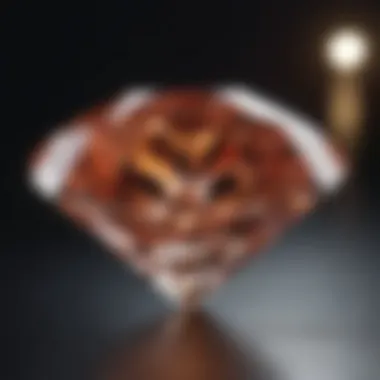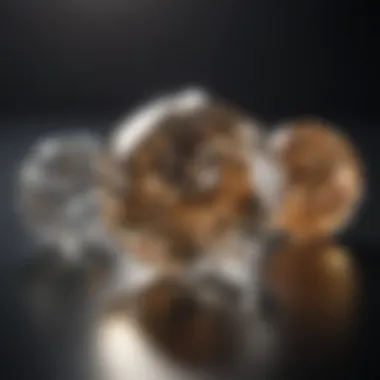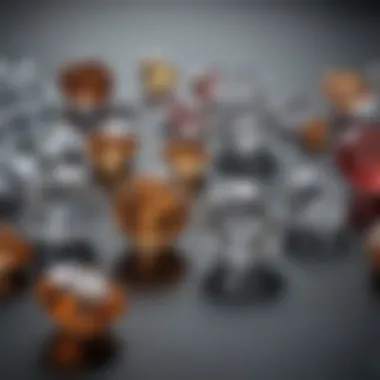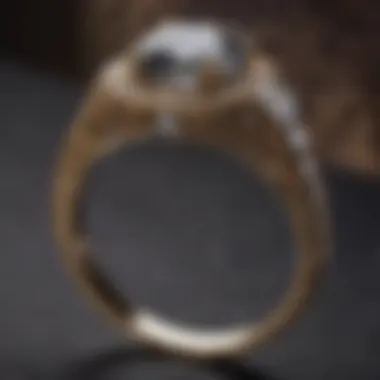A Comprehensive Guide to Picking Out a Diamond


Intro
Selecting the perfect diamond is both an art and a science. In a marketplace inundated with choices, understanding the essential aspects of a diamond helps to make an informed decision. This guide serves to navigate through the intricacies of choosing a diamond, emphasizing the Four Cs: cut, clarity, color, and carat weight. These factors determine not only the beauty of the stone but also its overall quality and value. Attention to practical considerations like budget, ethical sourcing, and aftercare can also significantly impact the purchasing experience and ensure satisfaction for years to come.
Gemstone Overview
Definition and Characteristics
Diamonds are a form of carbon that crystallizes in a unique structure known as isometric or cubic. They are renowned for their hardness, making them the most durable natural material known to humanity. This attribute, paired with their ability to refract light, lends diamonds their remarkable brilliance and fire. It is this combination of durability and aesthetic appeal that explains why diamonds have long been coveted for use in jewelry.
Classification of Gemstones
Gemstones can be classified based on a variety of criteria, including their mineral composition, rarity, and color. Diamonds fall under the category of precious gemstones, a title shared with rubies, sapphires, and emeralds. The classification often reflects market demand, historical significance, and the inherent beauty of the stones.
Key Characteristics of Diamonds:
- Hardness: Diamonds score a perfect 10 on the Mohs scale.
- Brilliance: Their ability to split light gives them a unique sparkle.
- Rarity: High-quality diamonds can be extremely rare, influencing their price.
Historical Significance
Ancient Uses and Cultural Importance
Historically, diamonds have held significant value across various cultures. Initially valued for their rarity and use in tools, they transitioned to symbols of wealth and power in ancient societies. For instance, Indian royalty adorned themselves with diamonds, viewing them as talismans offering protection in battle.
Myths and Legends Surrounding Gemstones
Various myths elevate the status of diamonds in cultural narratives. In many societies, they were believed to possess mystical properties. For example, ancient texts claim that wearing diamonds could bring invincibility and protection against evil. Such legends continue to contribute to their allure in the modern world.
Diamonds have been linked with engagements and fidelity, cementing their place in romantic traditions.
Understanding Diamonds
Understanding diamonds is a fundamental step for anyone interested in selecting a quality gem. This knowledge sets the foundation for making informed choices, whether one is a first-time buyer or a seasoned collector.
Diamonds are more than just stunning pieces of jewelry; they embody complex geological processes, diverse categories, and various qualities that can significantly affect their value and appearance. By comprehending these facets, individuals can appreciate what makes each diamond unique and desirable.
The Formation of Diamonds
Diamonds form under intense heat and pressure deep within the Earth, typically around 150 to 250 kilometers beneath the surface. They are a crystalline structure of carbon atoms, arranged in a tetrahedral formation. This formation is what gives diamonds their unmatched hardness and ability to refract light, resulting in their characteristic brilliance. The process takes millions to billions of years, giving natural diamonds a unique story that enhances their value.
Types of Diamonds
Diamonds come in several varieties, each offering distinct characteristics:
Natural Diamonds
Natural diamonds are formed without human intervention. Their long, natural birth process adds to their allure. They are often seen as a symbol of romance and commitment. Natural diamonds have unique features that may include inclusions—tiny imperfections that make each stone one-of-a-kind. While they tend to be more expensive due to their rarity and natural formation, this also means they hold significant emotional and investment value.
Synthetic Diamonds
Synthetic diamonds, or lab-grown diamonds, are created using technological processes that replicate the natural formation of diamonds. These stones have identical chemical and physical properties to natural diamonds but are generally less expensive. One major advantage is their environmental impact. Synthetic diamonds often come with a lower carbon footprint—making them a more sustainable choice. However, some buyers may prioritize the traditional value of natural diamonds, which can lead to differing preferences in the market.
Fancy Color Diamonds


Fancy color diamonds are distinguished by their vibrant hues, ranging from pink, blue, yellow, to rare shades like green and red. The color intensity and hue can vary significantly, affecting their rarity and value. Fancy color diamonds appeal to collectors and investors who seek something distinctive beyond the traditional clear diamond. The unique feature of these stones is their colorful palette, which can evoke unique emotional responses in wearers. However, the prices for fancy color diamonds can fluctuate greatly, and thus they can be both a compelling collection item and a considerable investment.
Understanding these types of diamonds allows potential buyers to make more strategic choices depending on their preferences, budget, and ethical considerations. This awareness is crucial for navigating the diamond market successfully.
"Knowledge about diamonds empowers buyers to select the perfect gem, making informed choices that reflect their personal tastes and values."
By exploring each type's characteristics, individuals can align their selections with personal significance or investment strategy. Thus, recognizing the variety within diamonds is a key part of choosing the right one.
The Four Cs of Diamonds
Understanding the Four Cs of diamonds is crucial for anyone looking to invest in these precious stones. This system stands for cut, clarity, color, and carat weight. Each characteristic plays a vital role in determining the quality and value of a diamond. Knowing how to assess these factors can enhance the buying experience and ensure that one makes an informed decision. These Cs serve as a standard by which diamonds are evaluated, offering both guidance and clarity for buyers.
Cut
Understanding Diamond Cuts
The cut of a diamond refers to how well the stone has been shaped and faceted. This aspect is perhaps one of the most critical factors to consider. A diamond that is cut well will reflect light beautifully and exhibit brilliance and fire, making it captivating. On the other hand, a poorly cut diamond may appear dull. The quality of the cut can significantly influence the diamond's overall appearance. The common cuts include round, princess, oval, and emerald. Each cut has its unique appeal and consumes light differently, maximizing the stone's sparkle.
Impact of Cut on Sparkle
The cut not only determines the diamond's shape but also its ability to reflect light. When light enters the diamond, it is refracted, creating that dazzling sparkle. A well-proportioned cut will optimize this effect, whereas an imprecise cut can lead to light escaping through the sides or bottom, which diminishes the sparkle. Therefore, selecting a cut that enhances brilliance should be a priority for anyone keen on making a wise diamond choice.
Clarity
Clarity Grading Scale
Clarity refers to the presence of internal or external imperfections within the diamond, known as inclusions and blemishes. The Gemological Institute of America, or GIA, uses a clarity grading scale ranging from Flawless to Included. A clear diamond will have fewer visible flaws, positively affecting its beauty and value. Understanding this grading system helps a buyer choose a diamond that meets their standards for clarity.
Identifying Inclusions
Identifying inclusions can be challenging. However, being aware of what to look for is vital. These imperfections can often be seen under magnification. Some will have little to no effect on the diamond's overall appearance, while others may be much more noticeable. Recognizing how inclusions impact clarity will allow buyers to make conscious decisions if they are willing to compromise in this area for a more favorable price.
Color
Understanding Diamond Color Grading
Color grading in diamonds is based on a scale from D, indicating colorless, to Z, representing noticeable color. Most diamonds in jewelry are graded in the G-I range, which signifies nearly colorless stones that appear white when mounted. It is crucial to grasp how subtle differences in color can affect appearance and desirability. A diamond's color may influence both its value and how it complements other elements, such as the setting.
How Color Affects Value
The color of a diamond significantly influences its price. Colorless diamonds are generally regarded as more valuable, creating higher demand in the market. On the contrary, diamonds with noticeable hues will often be less expensive. Knowing where on the grading scale a diamond falls helps in assessing whether the price reflects its market value.
Carat Weight
Carat Weight Basics
Carat weight represents the size of a diamond, where one carat is equal to 0.2 grams. Many buyers mistakenly believe that price increases linearly with carat weight. In reality, the value can jump significantly as carat weight increases, especially at key weights like one carat, 1.5 carats, and two carats. This factor is essential for budgeting when shopping for diamonds.
Price Variations by Carat
Understanding how price varies by carat weight assists buyers in navigating their choices sensibly. As mentioned, larger diamonds can see exponential increases in price. This fluctuation often means that two diamonds of equal quality but differing carats can have vastly different price points. For someone on a strict budget, knowing how to balance carat weight against other factors is indispensable.
Setting a Budget


Setting a budget is a critical step in the process of choosing a diamond. It lays the foundation for every decision that follows. Having a clear budget helps to narrow down options and ensure you are not overwhelmed by the vast variety available in the market. This ability to focus not only saves time but also enhances the overall shopping experience, leading to a more satisfactory purchase.
When it comes to diamonds, the price can vary significantly based on various factors, such as quality and vendor. Understanding your budget allows you to effectively balance factors like quality and personal preference without overspending. Setting a budget is about aligning your financial capability with your desire for a diamond, and doing so thoughtfully ensures that you make an informed choice.
Determining Your Budget
Determining your budget involves understanding how much money you are prepared to allocate towards a diamond. This stage is critical because it influences every aspect of your purchase decisions.
Factors Influencing Budget
Several factors affect the budget you should set. These include the Four Cs—cut, clarity, color, and carat; however, other personal preference factors also contribute. For instance, your relationship to the recipient plays a large role. A significant milestone, such as an engagement, may warrant a larger investment compared to a gift for a friend. Another aspect is market fluctuations; prices can change based on demand, especially for high-quality diamonds. Understanding these variables can help you establish a budget that is reflective of both your financial situation and purchase purpose.
In terms of uniqueness, one should consider future resale value as well. Given that diamonds retain value differently, investing slightly more in a high-quality stone can be a beneficial long-term choice.
Understanding Financing Options
Understanding financing options can provide flexibility in how you manage your budget. Various financing methods are available to help you afford a diamond. Options such as credit cards, personal loans, or layaway plans are popular. Using financial services can make higher-priced diamonds more accessible without immediate full payment.
Working with a jeweler who offers financing can be convenient, but it's vital to read the fine print regarding interest rates and fees. The unique feature of this strategy is that it enables buyers to take home a diamond without paying upfront, although it can lead to additional costs over time. Hence, clarity on terms is essential to avoid frustration later.
Value vs. Price
Understanding the difference between value and price is crucial for diamond buyers. These concepts affect how you perceive your purchase in the long run.
Defining Value in Diamonds
Defining value in diamonds is about recognizing what makes a diamond worth the investment beyond its monetary cost. Value often encompasses both the emotional significance of the diamond and its potential for appreciation over time. A diamond’s craftsmanship, heritage, and uniqueness add layers to its value. When a buyer can correlate these attributes with their budget and needs, decision-making becomes easier.
Also, diamonds from reputable brands often carry intrinsic value due to their provenance or certification. This aspect can assure buyers of quality, thereby enhancing the perceived value.
Price Comparison Strategies
Price comparison strategies can greatly impact your diamond-buying experience. Using these strategies allows you to determine fair pricing across different retailers. Researching multiple jewelers, both online and in-store, can help identify the best deal for the quality you desire. Comparing prices based on the same Four Cs specifications helps foster informed choices.
Additionally, leveraging online platforms that aggregate diamond prices can streamline the search process. The unique aspect of these strategies is that they arm consumers with knowledge; being well-informed about pricing trends can save money and ensure satisfaction with the final choice. However, it should be noted that some may find it overwhelming to navigate this information without expert guidance.
Ethical Considerations
The conversation surrounding diamonds has evolved significantly over the past few decades. Today, potential buyers are increasingly concerned about the ethical implications of their purchases. Ethical considerations can greatly influence not only the choice of a diamond but also the overall integrity of the jewelry industry. This section highlights why buyers should be informed about ethical sourcing and the complexities of conflict diamonds.
Responsible Sourcing
Responsible sourcing relates to ensuring that the diamonds purchased do not contribute to human rights violations or environmental degradation. As a consumer, it is your duty to ensure that the diamonds you select are sourced ethically. Many reputable jewelers now offer diamonds that are certified as conflict-free. These diamonds have been sourced from mines that adhere to strict ethical guidelines, minimizing the impact on communities and the environment.
When you buy from responsible sources, you contribute to sustainable practices in the mining industry. This can include supporting fair wages, safe working conditions, and community development. Many countries and organizations work towards these goals, and knowing where and how your diamond was mined can reinforce your confidence in your purchase.
Understanding Conflict Diamonds
Conflict diamonds, often called blood diamonds, are stones that are mined in war zones and sold to finance armed conflict against governments. The impact of these diamonds can be devastating, leading to severe human suffering. The global awareness around conflict diamonds led to the establishment of the Kimberley Process Certification Scheme in 2003. This initiative aims to prevent the trade in conflict diamonds through an international regulatory framework.
Despite this progress, challenges remain in effectively regulating the supply chain. Here are some key points to consider regarding conflict diamonds:
- Identification: Not all diamonds are easily traced back to their origin. This makes it difficult for consumers to ensure that they are purchasing conflict-free stones.
- Transparency: Ethical sourcing often requires transparency from jewelers. Understanding their supply chain policies is crucial to making an informed choice.
- Ongoing issues: While some diamonds are certified as conflict-free, many are still potentially tied to unethical practices.


It is your responsibility as a consumer to be aware of these issues. By choosing diamonds from certified ethical sources, you not only make a personal investment but also contribute to broader social and economic changes in mining practices. In the long run, this promotes a more humane and resilient jewelry industry.
Selecting a Retailer
When it comes to purchasing a diamond, selecting the right retailer is crucial. A reputable jeweler can significantly influence your experience and satisfaction. The quality of your diamond purchase extends beyond the stone itself; the retailer's integrity, knowledge, and service play essential roles. Understanding the landscape of jewelry retail helps buyers make informed decisions, ensuring that you acquire a diamond that truly meets your expectations.
Evaluating Jewelers
Certifications to Look For
When considering a jeweler, the certifications they possess are of utmost importance. Certifications indicate that a jeweler meets specific industry standards and practices. The gemological industry offers several certifications, with the Gemological Institute of America (GIA) and the American Gem Society (AGS) being among the most respected.
GIA provides detailed grading reports that outline the Four Cs of diamonds, which will help you understand the quality of your potential purchase. On the other hand, AGS focuses on cut quality, which is a critical factor influencing a diamond's brilliance. Having these credentials assures buyers that they are dealing with knowledgeable professionals, leading to better purchasing outcomes.
Some disadvantages exist, too. A jeweler might have certifications but may not always provide transparent information regarding the diamonds they sell. Therefore, while certifications are important, they should not be the sole criterion for evaluating a jeweler.
Online vs. Brick-and-Mortar
The choice between purchasing a diamond online or from a brick-and-mortar store is significant. Each option comes with its pros and cons.
Shopping online allows access to a broader variety of diamonds and often at competitive prices. It also permits convenient comparisons between different retailers. Furthermore, many online retailers offer detailed images and videos of their diamonds, providing a clear view of what you are purchasing.
However, the tactile experience of examining diamonds in-person cannot be understated. Buying from a brick-and-mortar retailer allows you to see the diamond closely, evaluating it against your preferences. Additionally, many individuals prefer direct interaction with a jeweler when making such a significant purchase, which can aid in building trust.
In essence, both options have advantages and disadvantages. Consider your comfort level, the type of shopping experience you prefer, and the availability of reputable retailers in your area when deciding between the two.
Reading Reviews and Ratings
Reading reviews and ratings is another essential aspect of selecting a retailer. It provides insight into the experiences of previous customers and the reputation of the jeweler. Customer ratings can reveal valuable information that may not be readily apparent. A high rating does not guarantee a perfect experience, but consistently positive reviews can indicate that a jeweler is dedicated to customer satisfaction.
Look at factors such as customer service, return policies, and quality of products. Reading reviews on platforms such as Reddit can provide a broader perspective and allow you to gauge how reliable a retailer is.
Post-Purchase Care
Post-purchase care is crucial for maintaining the beauty and value of your diamond over time. Diamonds, while durable, require proper handling and regular maintenance to ensure they remain in pristine condition. In this section, we will explore the key aspects of cleaning, maintenance, and insurance for your diamond, providing valuable insights that will help you protect your investment.
Cleaning and Maintenance
Regular cleaning of your diamond is essential to keep its brilliance and sparkle. Dirt, oils from skin, and dust can dull the appearance of a diamond. Thus, establishing a routine cleaning regimen is advisable.
You can clean a diamond at home using a simple solution of warm water and mild dish soap. Use a soft brush, such as a toothbrush, to gently scrub the diamond and the setting. Rinse thoroughly and dry with a lint-free cloth afterwards. For more intensive cleaning, professionals can offer ultrasonic cleaning services that bring your diamond back to its original condition.
In addition to cleaning, periodic checks for wear and tear are necessary. Look for any loose stones, worn prongs, or scratches on the setting. Addressing these issues immediately can prevent loss or further damage. Establishing a relationship with a trusted jeweler for maintenance services can prove beneficial in this regard.
Insurance for Your Diamond
Understanding Insurance Coverage
Insuring your diamond provides security against unforeseen events such as loss, theft, or damage. Understanding the coverage options is essential. Most insurance policies will cover the replacement cost of your diamond based on its evaluation price. This means that it is important to obtain an accurate appraisal from a certified gemologist.
A crucial characteristic of insurance coverage is that it can often be tailored to your needs. For example, some policies may cover accidental loss while others may only provide coverage in specific circumstances. Be sure to evaluate different providers to find a policy that aligns with your requirements.
However, one unique feature of insurance coverage to consider is how exclusions can vary by provider. Some may not cover wear and tear or certain types of loss. This can affect the overall protection your diamond has. Therefore, careful examination of policy terms is required to avoid surprises.
How to Insure Your Diamond
Insuring your diamond involves a straightforward process, yet it requires prep work. Start by obtaining a documented appraisal detailing your diamond's characteristics and value. Many insurance companies will ask for this before issuing a policy.
After that, choose an insurer who specializes in jewelry insurance. Look for those who have a good reputation among jewelers. Once you have your insurer, you can finalize the terms of the policy.
A key characteristic of this process is the documentation. Keeping all records organized, including the appraisal, purchase receipts, and photographs, will aid in processing claims efficiently. One advantage of working with jewelers is that they often can recommend trusted insurers based on their network.







